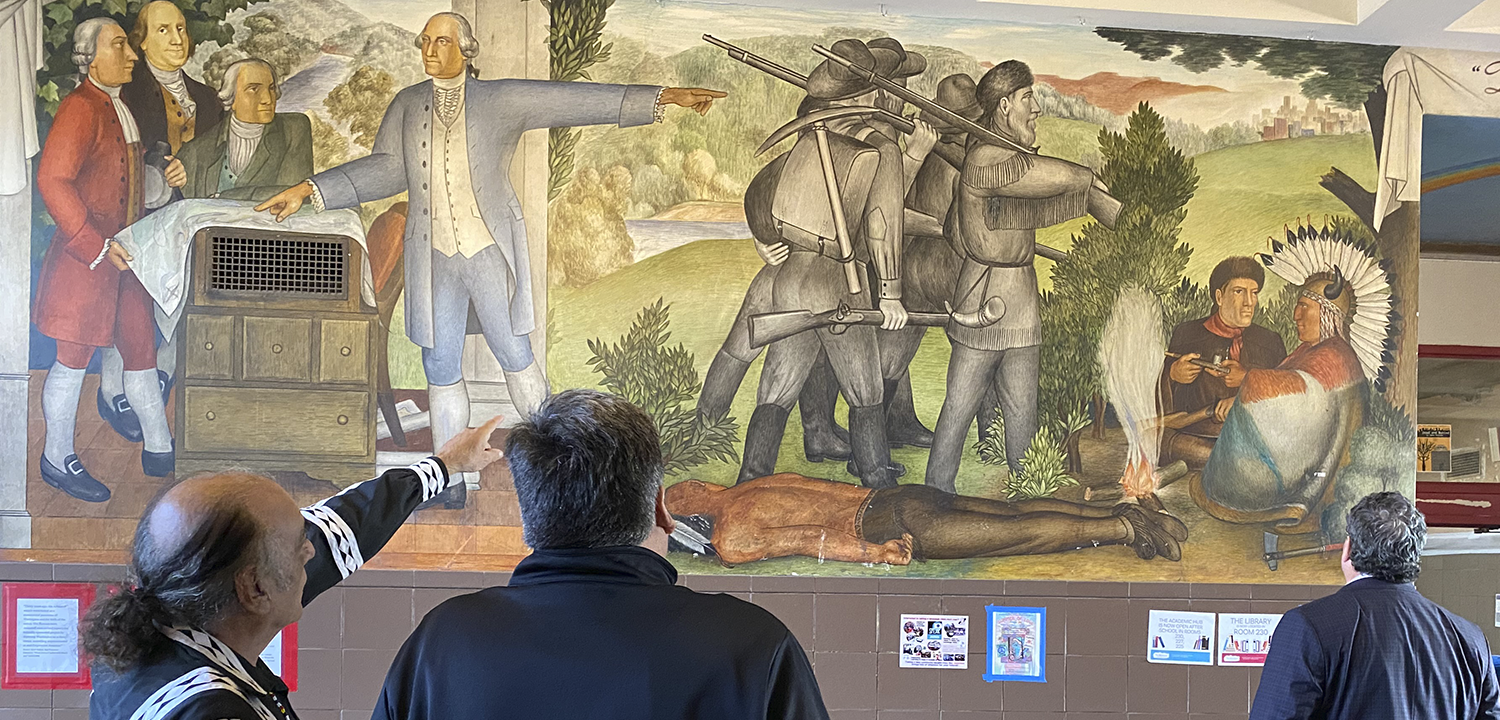The high school mural that’s spawned years of shouting matches, lawsuits, and national media animosity towards San Francisco gets the documentary treatment in Town Destroyer, playing at The Roxie and the Mill Valley Film Festival.
One of the many grievances aired in the Festivus leading up to this year’s SF school board recall election was the board’s decision to paint over part of a mural at Washington High School, a section of Victor Arnautoff’s massive, 13-panel, 1,600 square foot “The Life of Washington” mural at the Richmond District’s Washington High School.
The mural has been there since 1936, but one section of the mural has created a controversy that goes back to at least 1986; a section of George Washington and a group of homesteaders standing over the body of a slain Native American. After the board voted to paint over it, alumni groups sued, so the board agreed to merely cover the offending section. That was also shot down in the courts, and ultimately, the post-recall school board reversed and voted to keep the mural.
Berkeley filmmakers Alan Snitow and Deborah Kaufman explore both boisterous sides of this debate in their new hour-long documentary Town Destroyer (named for the nickname Seneca leaders gave to George Washinton, but you understand the double meaning.) Town Destroyer is playing as part of the Mill Valley Film Festival with a screening Saturday afternoon at The Roxie (and with an extended run at the Roxie November 4-10). SFist spoke to the duo about the mural that spawned the loaded phrase among students “Meet me at the dead Indian.”
“In the old school yearbooks that we looked at, I’m not kidding, I’m using their words, it was a tradition of the school to say ‘Meet me at the dead Indian,’” Kaufman tells SFist.

“It can't be emphasized enough the power of this image,” Snitow adds. “This corpse is full-size, it’s a life-size image, it’s at eye-level, you can’t miss it. It’s at the dead-center of the school, in other words, when you walk in from any direction into that school, that’s the first thing you’re going to see.”
“So this is an extraordinary artistic provocation by Arnautoff to put that extremely powerful and provocative image there,” he continues. “When he painted it, there was no acknowledgement of Native genocide in California.”
One of the splits in this emotionally charged debate was that the New Deal-era painter Arnautoff, a radical leftist in his day and member of the Communist Party, was critiquing Washington’s legacy, and the work should be seen as such.
“He painted Washington as an owner of slaves. It was not taught that Washington was a slave owner in schools,” says Snitow. “So this was a radical act at the time.”
“But times change. So nowadays, people don’t necessarily want to see themselves as victims anymore.”
Kaufman adds, ”It’s a like recapitulation of the initial oppression rather than a validation of empowerment. So, you know, we get that.”
People with Indigenous backgrounds generally hate the mural, but as seen in the film, several Native elders have called for it to be kept as is. “No community is monolithic,” Kaufman tells us. “Native Americans have different opinions. ‘Native Americans’ is already saying something that’s not true. They’re nations, they’re Native nations. Within each nation there's a variety of opinions, just like in anyplace else.”
“Certainly amongst white leftists, many of whom were vehemently against censorship, censoring murals in any way, there was a split of opinion. And generationally, younger people have seen this differently than older people.”
Snitow emphasizes that “Most people want to see some reconciliation about this and understand the grievances on Native Americans who look at this symbol and are offended, and are triggered by seeing a dead Indian — a murdered Indian — in the middle of the school. And they also understand people who say wait a minute, this is a great work of art and is a critique of George Washington and his role in both the genocide of Native Americans, and well as the slavery of African Americans.”
The mural and its response have promoted gnashing of teeth for decades, and thus far, also among audiences at Town Destroyer’s early screenings. “So far in our two public screenings that we've done, people have not been able to stop talking,” Snitow says, and jokes that at the Q&A sessions after both screenings, “People had to be kicked out of the room.”
Town Destroyer plays at the Roxie on Saturday, October 15 at 1:45 p.m. and is available via streaming through Sunday, October 16. Tickets here, and it returns to the Roxie November 4-10.
Related: Washington High Alums Sue Over Contentious Mural [SFist]
Image: Snitow-Kaufman Productions

